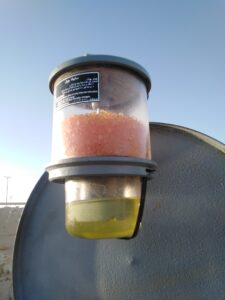Transformer oil is an essential part of power transformers that helps in the cooling and insulation of electrical conductors.
However, when the transformer oil comes in contact with moisture, it can lead to the degradation of insulation, corrosion of conductors, and ultimately result in the failure of the transformer.
Hence, it is crucial to protect transformer oil from moisture to maintain the efficient operation of transformers. In this article, we will discuss in detail how to protect transformer oil from moisture.
Table of Contents
Understanding the causes of moisture in transformer oil
Before we proceed to understand the methods of protecting transformer oil from moisture, it is crucial to understand the sources of moisture in transformer oil. Moisture can enter the transformer oil from various sources, such as:
- Condensation: When the temperature of the transformer drops, it can lead to the condensation of water vapor from the surrounding air, resulting in the entry of moisture into the transformer oil.
- Ingress of external moisture: If the transformer is not properly sealed or the gaskets are worn out, external moisture can enter the transformer oil.
- Absorption of moisture from the cellulose insulation: The cellulose insulation used in transformers has a high affinity for moisture. Hence, if the insulation is not properly dried, it can absorb moisture from the surrounding air and transfer it to the transformer oil.
Now that we understand the sources of moisture in transformer oil, let’s discuss the methods of protecting transformer oil from moisture.
Methods of protecting transformer oil from moisture:

- Desiccant breathers: Desiccant breathers are devices that help in removing moisture from the air before it enters the transformer. These breathers contain a desiccant material that absorbs moisture from the surrounding air, thus preventing its entry into the transformer.
- Dehumidifiers: Dehumidifiers are devices that remove moisture from the air by cooling it below the dew point, resulting in the condensation of water vapor. The condensed water is then collected in a container, thus preventing its entry into the transformer.
- Silica gel: Silica gel is a moisture-absorbing substance that can be placed inside the transformer to absorb moisture. Silica gel can be regenerated by heating it, thus making it reusable.
- Vacuum drying: Vacuum drying is a process in which the transformer is placed in a vacuum chamber, and the pressure is lowered to a level where the moisture inside the transformer starts boiling off. The boiled-off moisture is then removed by a vacuum pump.
- Monitoring moisture content: Regular monitoring of the moisture content in transformer oil can help in detecting the presence of moisture in the oil at an early stage. This can help in taking corrective actions before the moisture content reaches a critical level.
Conclusion:
Protecting transformer oil from moisture is crucial to maintain the efficient operation of transformers.
The methods discussed in this article can help in preventing the entry of moisture into the transformer oil, thus prolonging the life of the transformer.
Regular maintenance and monitoring of the transformer can also help in detecting the presence of moisture in the transformer oil and taking corrective actions to prevent its entry.
Install my Free Android App on Google Play:
Electrical Cables Most Common Tables “Electrical Cables Tables”
And, my Electrical Calculations App “Fast Electrical Calculator”
Discover more great content by subscribing to My channel
Looking to stay ahead of the game in the world of electrical engineering? Subscribe to my YouTube channel and gain access to exclusive content you won’t find anywhere else!
The staff I recommend
(Amazon Affiliate Links to products I believe are high quality):
- Economy 120 Volt/60Hz AC Power Source – Step-Down Voltage & Frequency Converters 1800W
- UNI-T Digital Multimeter Tester UT139C
- 50-Amp Extension Cord for RV “100ft”
- Voltage Stabilizer 110/220v
- Hair Dryer “best selling“
- TOSHIBA EM131A5C-BS Countertop Microwave Ovens
Disclaimer: This contains affiliate links to Amazon products. I may earn a commission for purchases made through these links.
